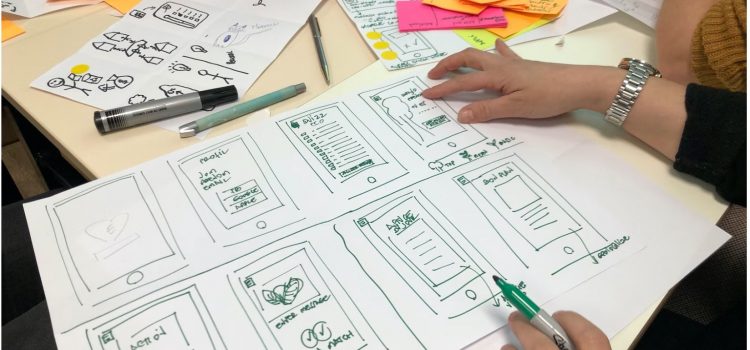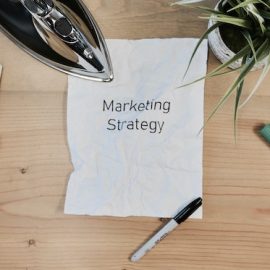
When do people make purchasing decisions? How can you create that moment and make the most of it?
Russell Brunson’s Epiphany Bridge is a framework to help you tell a story about your product. It has proven to be an effective way to convey the important details of your product and get people excited about it.
Keep reading to learn how to present your product and company in a way that will turn customers into lifelong fans.
Russell Brunson’s Epiphany Bridge
Russell Brunson’s Epiphany Bridge is designed to transport people to an “aha” moment. He writes that, to effectively engage your customers, you need to tell them not only about your product but also about the story behind it—the problems you faced and how you came up with your idea to solve them. By sharing this story, you’ll help your audience understand the “aha” moment that hooked you into your idea emotionally, and it will likewise hook them emotionally.
(Shortform note: Brunson doesn’t explain his term Epiphany Bridge but we can infer that the bridge is the infrastructure, in the form of a story, that brings a customer from a place of reluctance to a place of eagerness to purchase your offer. The epiphany, naturally, is the moment of sudden understanding they experience regarding how to solve a problem or challenge. In literature, an epiphany is often used as a turning point in a story, and Brunson’s use of the term aligns with that purpose, as it’s aimed at bringing about a turning point in their behavior.)
Brunson emphasizes that this is the only way to spur them to become customers because people make purchasing decisions when they’re emotionally invested in an idea, not when they logically understand it. Thus, even if they mentally understand and agree with your concepts, they won’t adopt them if they’re not emotionally involved, and your company won’t change their lives.
| Why We Buy Emotionally In Pitch Anything, Oren Klaff also writes that to convince people to buy your offer, you must appeal to their emotions. He writes that people don’t make decisions with their neocortex—their “thinking” brain—but instead with what he calls their “croc brain.” This is the most primitive part of the brain, and it processes information before any other part so that it can filter out threats and look for opportunities that can aid survival. It only engages the neocortex to think through complex decisions when it decides that new information is worth paying attention to. Klaff writes that desire is one of the urges that spurs the croc brain into action, and he notes that one of the ways we can spark desire is to present a puzzle. Humans instinctively like figuring out puzzles because we like a bit of a challenge. He also writes that we’re drawn to tension because tension indicates consequences and importance. Brunson’s “aha” moment incorporates both of these: It presents a tension-filled puzzle (the problem you were initially trying to solve) and offers a solution. By engaging your audience in this puzzle-solving exercise, you can engage their emotions and thus, their croc brain, which will pave the way for the rest of their brain to get on board with your idea. |
Brunson’s Epiphany Bridge framework has five parts, and he writes that it’s useful not only because it inspires excitement but also because it allows you to go into as much or as little detail as you need when presenting your idea. If you have an hour-long training session, you can review each of the steps in detail. But, if you have only 60 seconds, you can give a quick overview of your product by focusing just on the broad concepts of each step, but your message will still be effective.
(Shortform note: Flexibility of your sales message is important because it allows you to engage potential customers at different points in their purchasing journey. People who aren’t familiar with your product haven’t started their journey yet and probably won’t be as open to a long presentation, so a quick “elevator pitch” highlighting the main things you want them to know would be the best approach. People who are attending a training session have already committed to at least considering your offer, and so will be more inclined to listen to a long speech.)
The five parts of the Epiphany Bridge:
- The introduction
- The journey and conflict
- The new opportunity
- The framework
- The successes
Brunson notes that the steps of this framework are similar to many traditional storytelling structures, which start by introducing the hero’s original world and then bring in antagonistic forces, failed attempts at success, helping characters, struggles (both internal and external), and finally, resolution and success.
(Shortform note: In Wired for Story, Lisa Cron explains that the human instinct to follow stories that have these traditional elements comes from an evolutionary need to learn about dangers. As humans evolved, we developed storytelling strategies that aligned with how our brains process information, and as a result, we’ve learned to pay attention to stories that follow a somewhat predictable structure—one that Brunson’s techniques adhere to.)
Step 1: The Introduction
Start by telling your audience your framework’s name and then giving some background about what your life was like before you came up with your idea (your “original world,” in storytelling language). Mention the problems you faced—both externally, like financial struggles, and internally, like having a fear of never reaching your potential. Brunson advises that the problems you name should be similar to problems your audience faces, so they’ll identify with you and your process.
Finally, mention some things you did to try to resolve your problems but weren’t successful at (for example, maybe you tried selling dog-training services but couldn’t get your business off the ground).
(Shortform note: This step is aimed at helping your audience identify with you, which many sales professionals agree is the key to encouraging sales. In New Sales. Simplified., Mike Weinberg writes that the problem with most presentations is the salesperson launches into a speech focusing on the company and its products rather than on the customer and their needs. Customers will instinctively resist this kind of pitch because it won’t seem relevant to them. Brunson’s method of naming the challenges they’ve faced and exploring the fact that, like you, they’ve struggled to overcome them is a time-tested way to shift the focus onto them and prevent that resistance.)
Step 2: The Journey and Conflict
In this step, you’ll describe the inspiration that started you on the path toward your idea. For example, maybe someone asked you why you aren’t targeting pet stores, and that got you thinking about the potential of that business model.
Then, describe the obstacles you faced—perhaps your attempts to contact pet stores were ignored, or your initial classes went poorly.
Also, mention in this step what you stood to lose if you failed—the stakes of your story. Were you close to being evicted from your apartment? Would you not be able to afford grad school if you couldn’t develop this source of income?
(Shortform note: This step is where, in terms of storytelling, you jump out of Act 1 and into the more active Act 2, where you purposefully start working toward a goal (prompted in Brunson’s structure by an outside suggestion), and you increase the tension (Brunson’s “stakes”). This keeps your story moving and also keeps your audience attentive, as they may lose interest unless they sense increased risks to your character.)
Step 3: The New Opportunity
In this step, you’ll discuss the epiphany you had that led you to your solution. You’ll talk about the expert who guided you to your aha moment, the realization itself, and the new opportunity you developed based on this epiphany.
For example, you could tell them about the zookeeper who taught you how to speak an animal’s language, and your aha moment when you realized that if you could teach others how to speak dog, your dog training classes would take off. Then you’d describe the dog dictionary you wrote and the audiobooks you recorded as part of your training classes.
(Shortform note: This step aligns with the “midpoint” of a traditional storytelling structure, which is when, halfway through your tale, you reveal a momentous discovery that marks the point when your main character shifts from reactive to proactive. At the midpoint, your hero recognizes the truth of their situation and how to work toward a solution. In Brunson’s structure, this realization, or epiphany, likewise tells of the moment when you stopped reacting to the hand you were dealt (as in the previous step, where you were still making poor choices that led nowhere) and instead came up with a new idea that allowed you to take control of your situation—your new opportunity.)
Step 4: The Framework
Here you’ll describe the framework you’ve developed to accompany your product. You’ll start by outlining it in broad strokes, touching on its goal and the main steps needed to achieve it.
Brunson warns that if you’re using this Epiphany Bridge to sell your product to potential customers, you shouldn’t go into further details in this step. Outline your framework’s strategy but not the specific tactics and techniques within it. Only describe the specific techniques to customers who have already purchased your product.
(Shortform note: Oren Klaff likewise advises that when describing your offer, you should only mention the highlights so as to grab your audience’s attention but not overwhelm them with details that won’t appeal to their primitive croc brain. He recommends that you structure this overall description in a slightly different way than Brunson does, using this format: “This is for [target customers] who are unsatisfied with [current market options]. My idea is a [new product or category] that provides [key benefit]. Unlike [competitors], my idea [has these key features].” While this structure doesn’t touch on the steps your customer would take to adopt your idea, it’s another way to give a brief overview of your idea’s functionality and purpose.)
Brunson argues that withholding information is not just a way to protect sales, but more importantly, it’s a way to convince people to adopt your ideas. It’s a quirk of human nature that if people are told everything they need to know upfront, they’ll listen, nod, and then go on about their lives as usual. It’s only when you create excitement and desire but don’t tell them everything they need to know that they’ll be motivated to fully buy into your program.
Thus, he writes that the only way to create true, lasting excitement for your product is to withhold the details of how it works.
(Shortform note: Psychologists offer some reasons why withholding the details of your offer may increase your audience’s interest: It can cause cognitive dissonance—mental discomfort that occurs when you harbor conflicting emotions or thoughts. In this case, your customer will feel (on one hand) the desire to find out more and (on the other hand) frustration at not knowing more. When people have this sort of mental discomfort, they instinctively try to fix it, which may lead them to pursue your idea so they find out more and therefore resolve the frustration they feel.)
Step 5: The Successes
In the final step, talk about how your framework and product have helped you achieve your goals, both internal and external.
Then, lastly, discuss how your framework has helped others—this offers the ultimate proof of your concept. People are likely to be skeptical of any service or product if you can only show that it’s worked for you—they’ll assume you have special circumstances that helped it be successful (for example, maybe dogs in your training classes pay attention to you because you naturally smell like raw beef—it’s only when you can point to others who successfully trained their dogs using your dog-language lessons that your program will seem credible).
(Shortform note: Weinberg agrees that an important characteristic of a good sales story is that it’s reality-based. If your story isn’t backed up by a provable track record, it won’t capture your audience’s attention. He notes that another drawback of pushing a sales message that’s not backed by experience is that it can be embarrassing and demotivating for salespeople to deliver—they don’t want to be associated with a message that sounds phony any more than your customers do. By mentioning the success of others, you can position your idea as reality-based and you can tap into what Robert Cialdini calls, in Influence, your audience’s desire for social proof: the human instinct to decide what’s right based on what others think.)






